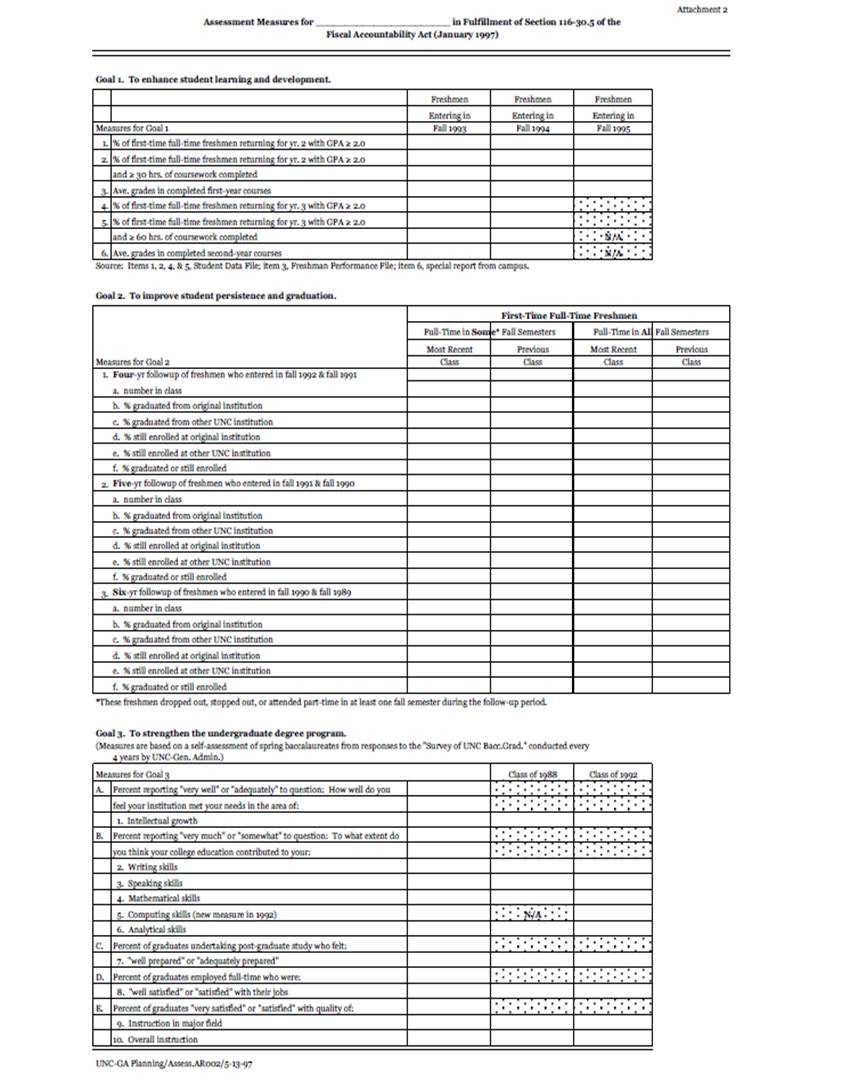The
UNC Policy Manual
400.2.2
Adopted 05/08/92
Accountability/Goals
and Assessment Measures
The UNC Fiscal
Accountability/Flexibility Act, which was enacted by the 1991 General Assembly
as a part of the appropriations bill, Chapter 689 of the 1991 Session Laws,
authorized the Board of Governors to designate one or more institutions as
special responsibility constituent institutions. Since the adoption of this policy, all
campuses have been awarded this designation.
Section 116-30.5 of the Act provides that:
The
Board of Governors shall require each special responsibility constituent
institution to include in its institutional effectiveness plan those assessment
measures that are determined by the Board to be measures that will assure some standard
measure of student learning and development in general undergraduate education
at the special responsibility constituent institutions. The intent of this
requirement is to measure the impact of G.S. 116-30.1 through G.S. 116-30.5,
establishing and administering special responsibility constituent institutions,
and their implementation on undergraduate student learning and development.
The Board of Governors adopts the attached goals and assessment
measures for special responsibility institutions. Using these measures, these institutions will
focus attention on student performance during the first two years, track
student progress during the next two to four years, and follow up every four
years with an assessment by baccalaureate graduates of their educational
experience as undergraduates.
Fiscal
Accountability Goals and Assessment Measures
Goal 1. To enhance student learning and
development.
The performance of all first-time
full-time freshmen will be reported on the following measures:
1. Percent
completing the first year with a GPA equal to or greater than 2.0.
2. Percent completing the first year
with a GPA equal to or greater than 2.0 and with 30 or more credit hours or
coursework completed.
3. Average grades
in first year courses completed.
4. Percent
completing the second year with a GPA equal to or greater than 2.0.
5. Percent completing the second year
with a GPA equal to or greater than 2.0 and with 60 or more credit hours of
coursework completed.
6. Average grades
in courses completed.
Goal 2. To improve student
persistence and graduation.
The persistence and graduation rates of all first-time freshmen,
including those student who transferred to another UNC institution — with a
comparison of those students who attended full-time in all fall semesters with
those who attended full time in their first-time semester but part-time in one
or more succeeding fall semesters — will be reported for the following years:
1. Four-year
persistence and graduation rates.
2. Five-year
persistence and graduation rates.
3. Six-year
persistence and graduation rates.
Goal 3. To strengthen the
undergraduate degree program.
The self-assessment of spring baccalaureate graduates in the Class
of '92 will be compared to the self-assessment of the spring graduates in the
Class of '88 on the following measures which evaluate their undergraduate
educational experience:
1. intellectual
growth
2. writing
skills
3. speaking
skills
4. mathematical
skills
5. computing
skills (new measure in 1992)
6. analytical
skills
7. preparation
for graduate and professional studies
8. job
satisfaction reported by fully employed graduates
9. overall
instruction
10. instruction in
major field
The assessment measures related to Goal 3 will be reported every
four years, following the quadrennial administration of the baccalaureate
graduate survey. All other measures will
be reported by the special responsibility institutions as a part of their regular
institutional assessment reports.
